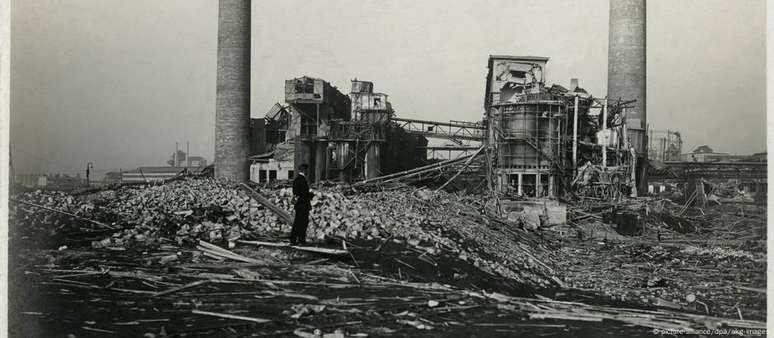An explosion in the BASF area near Ludwigshafen on September 21, 1921 turned into a catastrophe It was 7:32 a.m. on September 21, 1921, a Wednesday. In Munich, two muffled sounds were heard. Not too loud, but loud enough to make people wonder where they were coming from, what was behind them. The answer became known only a few hours later.
giant crater
About 300 kilometers away, in the city of Ludwigshafen, on the banks of the Rhine River, a thunderous explosion had occurred: the site of the catastrophe was the headquarters of the BASF company (short for Badische Anilin- und Soda-Fabrik) in Oppau, a northern suburb of Ludwigshafen. At the site of the explosion, a crater 90 meters wide, 120 meters long and 20 meters deep opened up. 561 people died and 1,952 were injured.
Two explosions were recorded: first a smaller one and then a larger one, with catastrophic effects in all directions. The cause: in a deposit of ammonium sulphate with saltpeter, an attempt was made to dilute the mixture with small explosions, so that the fertilizing compound would not solidify and petrify. If this were to happen, it would be impossible to transport the fertilizing compound.
The test explosions and subsequently around 20,000 routine explosions did not raise any suspicion that such a catastrophe could occur, according to Rolf Haselhorst of the BASF fire brigade:
“In principle, at that time, there was no experience that such an blasting process, if applied incorrectly, could cause serious damage. The level of knowledge was not yet that high. It was a product that had started to be manufactured five years ago, or six years earlier. But the problem of its petrification in large deposits had been known for a long time and had been solved with blasting for years, so there was no awareness of the effects that the applied blasting could cause. examined and approved by the German safety authorities, which are being used successfully.”
If explosions were heard in Munich, one can imagine the damage caused in the area of the accident. The BASF factory was left in ruins, as was the suburban district of Oppau. Of the approximately one thousand existing houses, 80 percent were completely destroyed. No building was left unscathed. Roofs were torn off houses within a radius of 25 kilometers.
Damage was also reported in the neighboring city of Mannheim, on the opposite bank of the Rhine, as well as in Heidelberg, 30 kilometers away. So many windows were shattered there that traffic had to be stopped. Damage was also reported in Frankfurt, 90 kilometers from the site of the explosions.
Rolf Haselhorst explained that prevention has been significantly expanded in this way: “For both explosions and fires, there are now certain processes in which the accuracy is checked already in the planning phase, before the start of construction. What are the plausible risks and possibilities? The safety requirements that a company has to meet have increased enormously. This ranges from the location to the examination of the smallest technical details of the company, with regard to the aspect of long-term safety.”
Damage repair
It took three years before the damage caused by the catastrophe could be completely repaired: 457 new houses were built and almost 700 renovated. 31 architects and 40 construction companies worked on this. The aid provided immediately after the explosions was also impressive: 7.5 thousand homeless people were housed in tents, receiving what they most urgently needed, especially blankets and clothes. They had lost practically everything they owned.
The 1921 accident was not the only explosion that occurred in the premises of BASF. In the following years, others were recorded, but they did not cause any victims.
Source: Terra
Rose James is a Gossipify movie and series reviewer known for her in-depth analysis and unique perspective on the latest releases. With a background in film studies, she provides engaging and informative reviews, and keeps readers up to date with industry trends and emerging talents.






